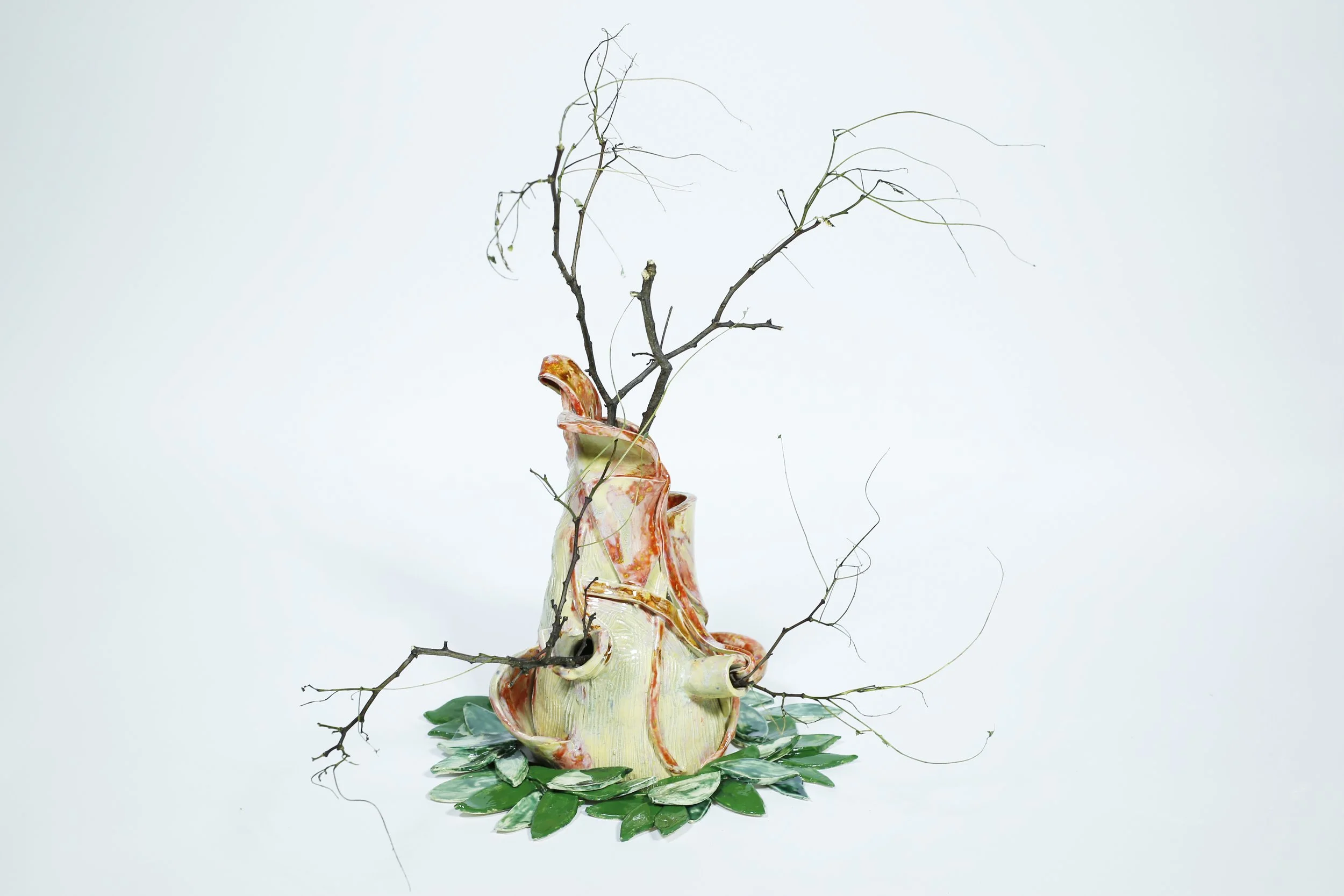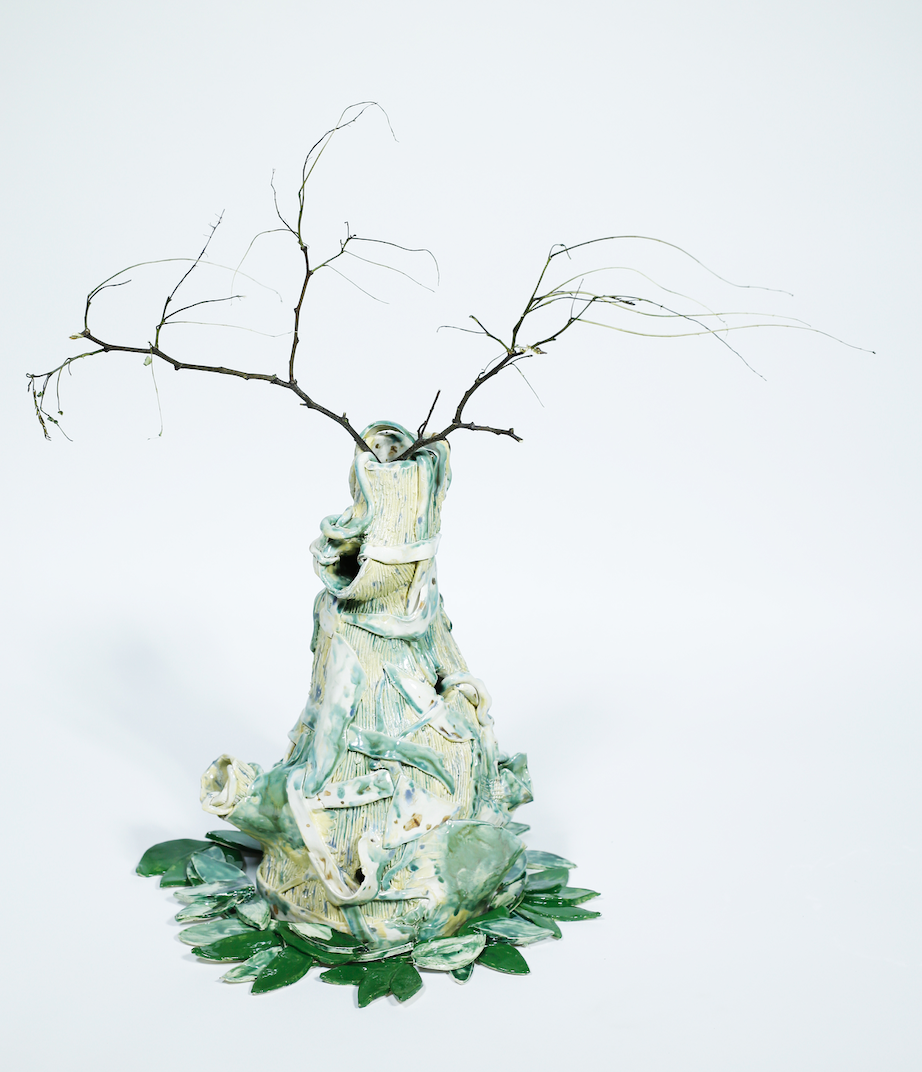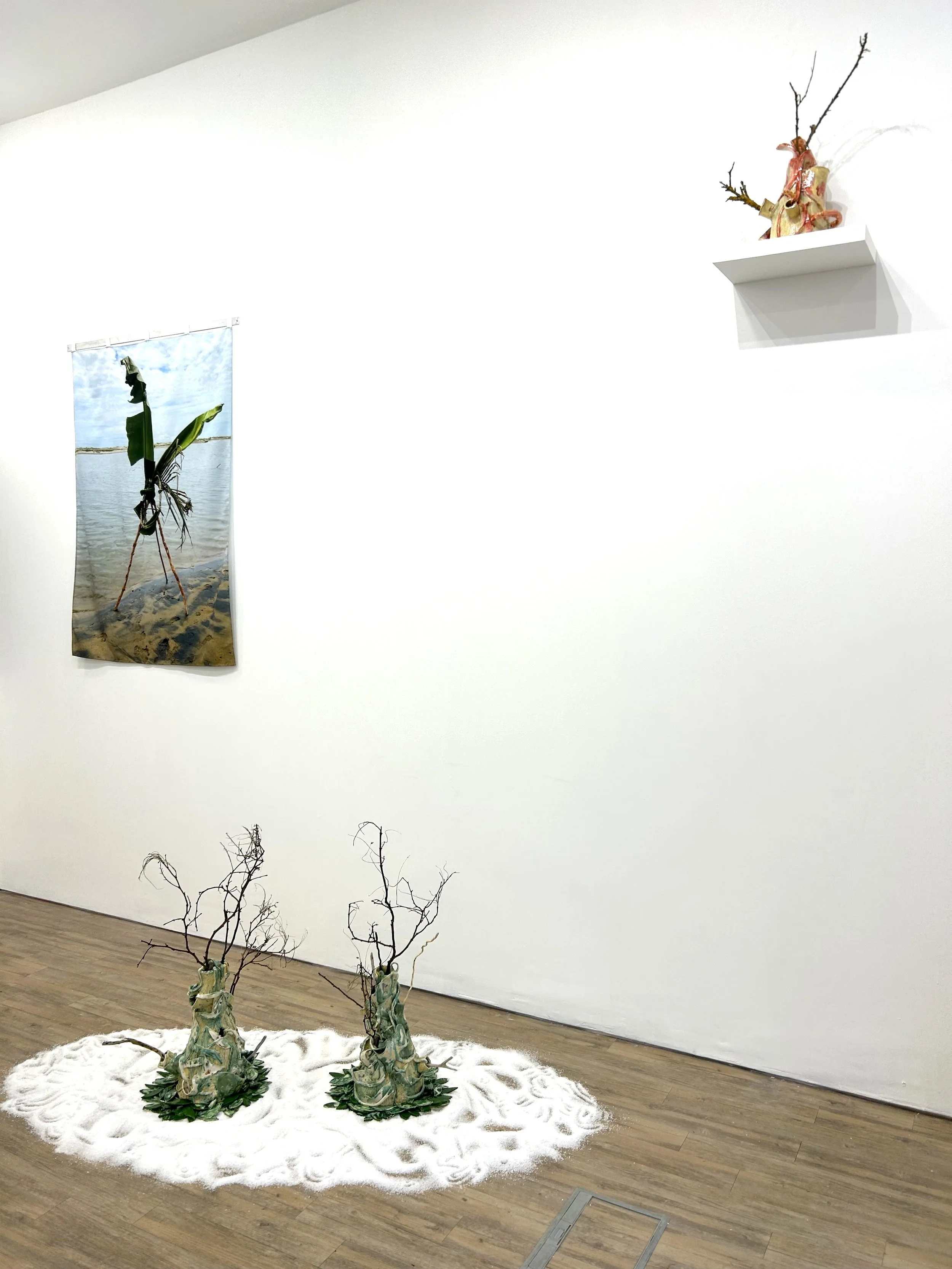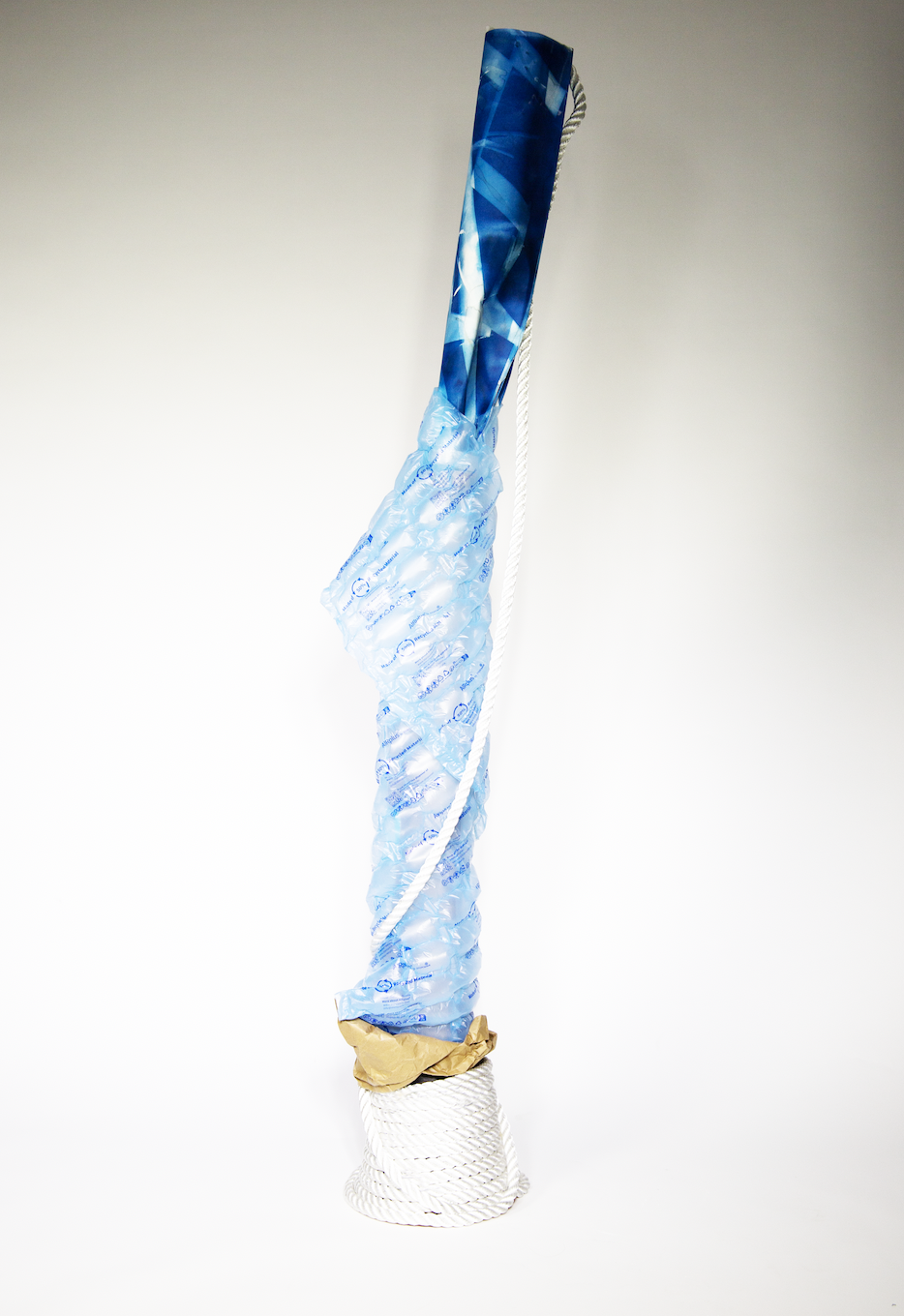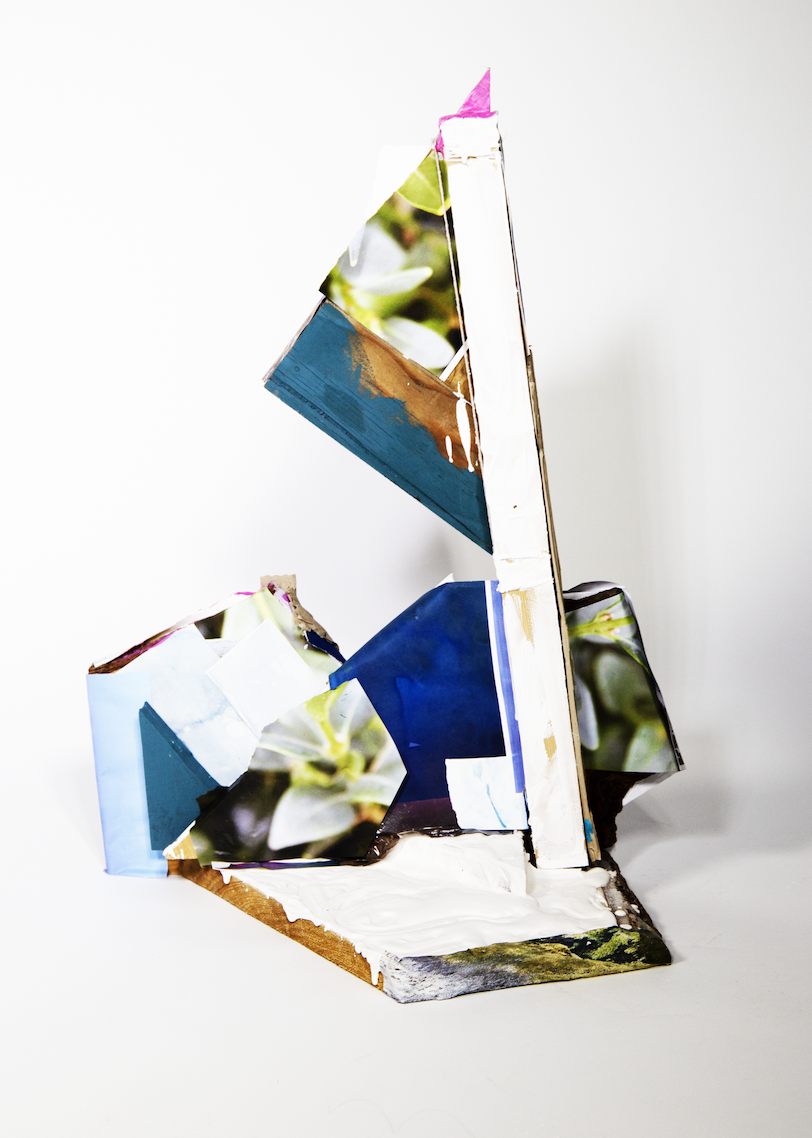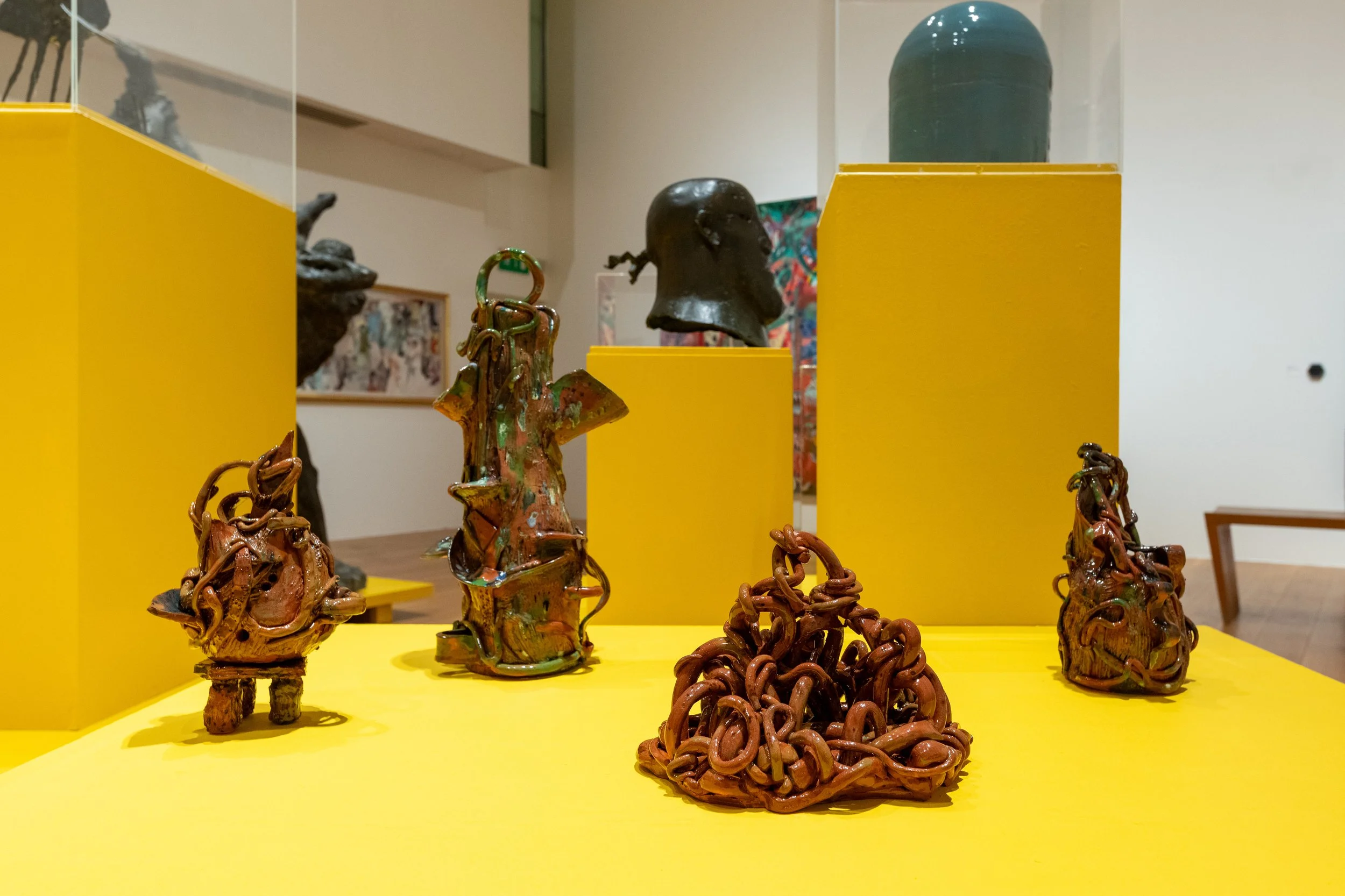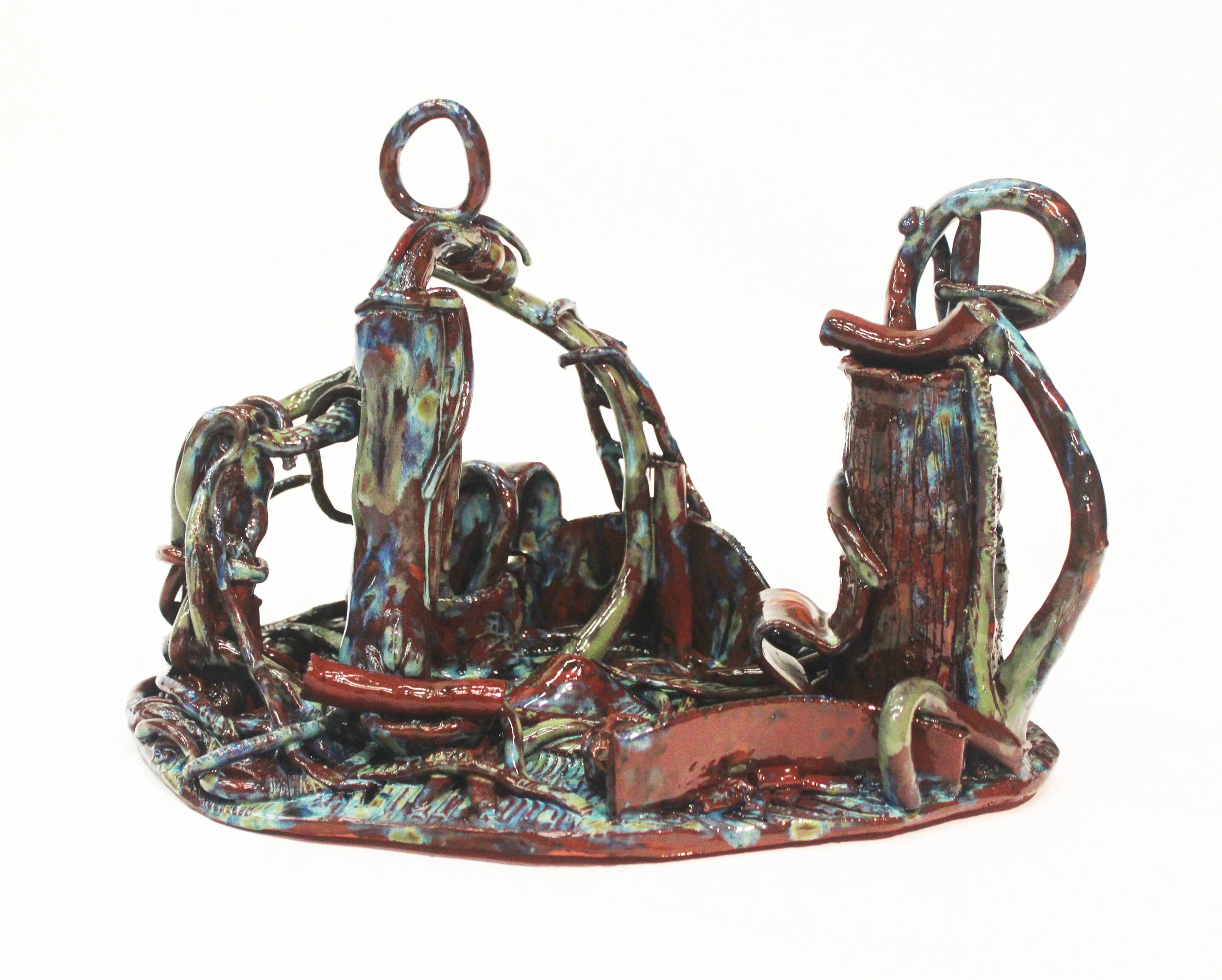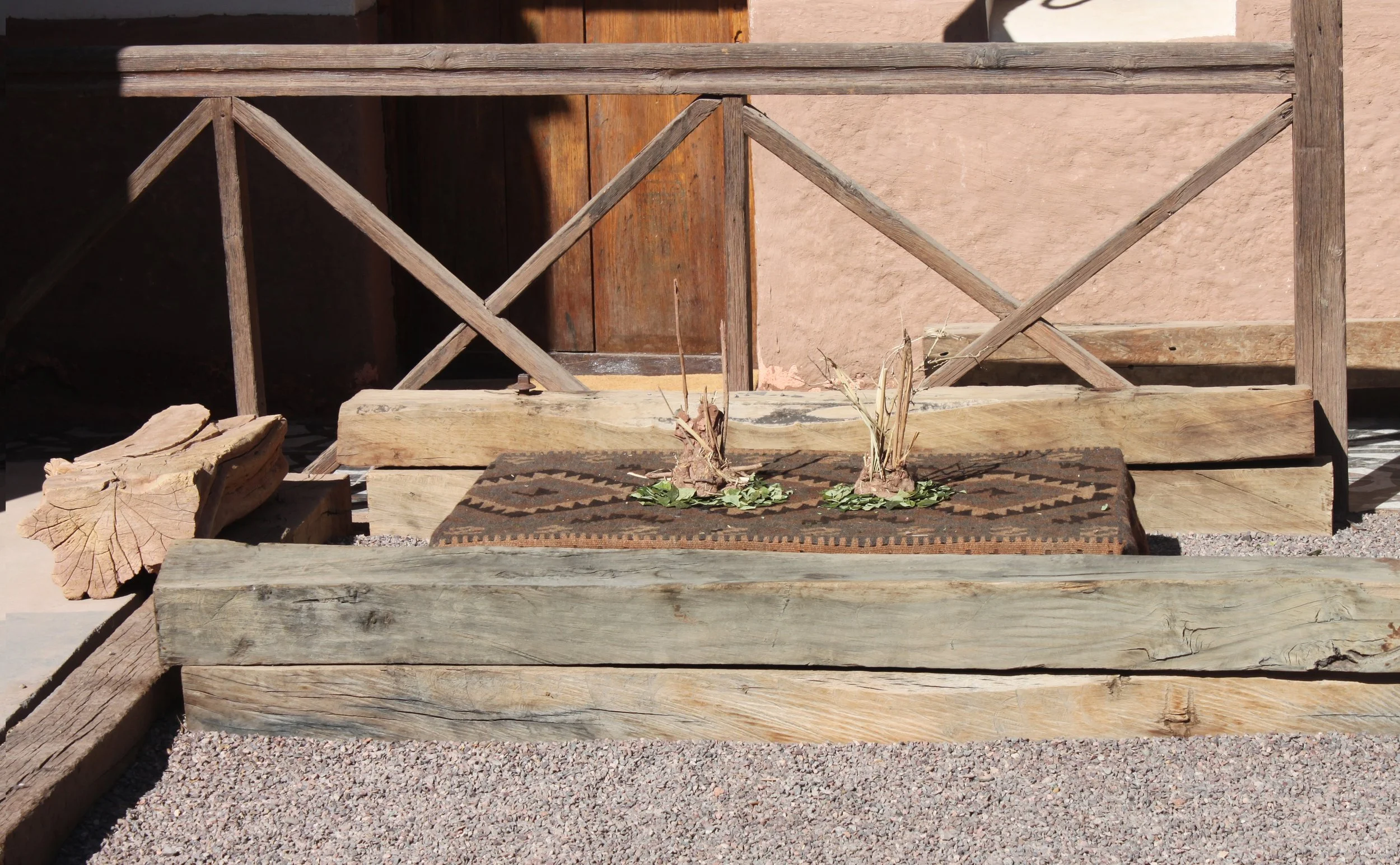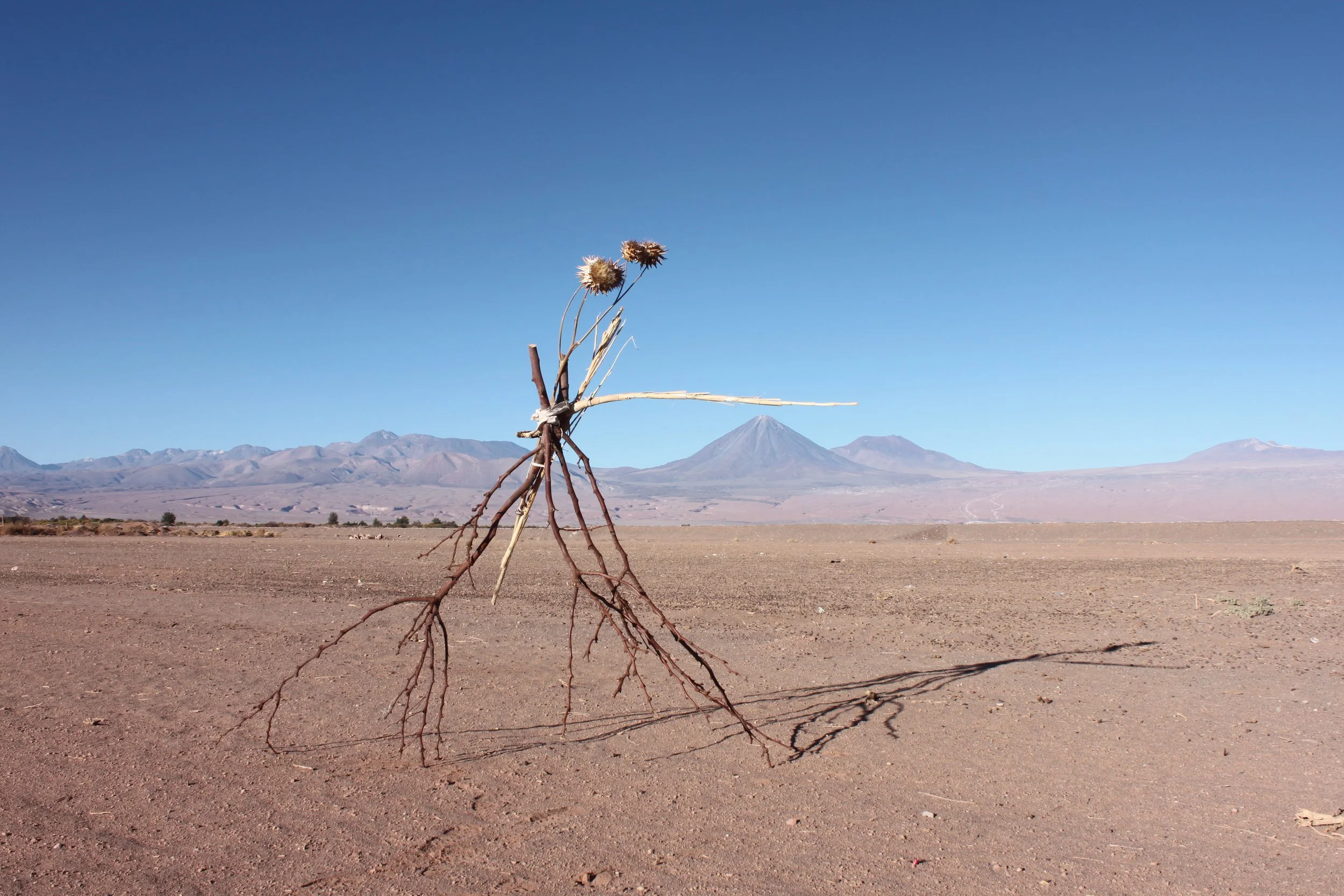This page showcases works that inform and are part of the current PhD research project which considers what it means to have a material practice in the context of climate change.
The leaves fell, falling, until the only tree was the falling itself.
2025
Glazed ceramic, driftwood, found natural materials, salt.
Dimensions Variable
Install shot of Landscapes of Hope exhibition School Gallery, Folkestone, 2025
Snakes and Ladders
2024
Glazed ceramics
Dimensions variable
Shown in Material Thinking at the Lightbox, Woking
Photo credit Deniz Guzel
Your Place and Mine
2024
Mixed media on reclaimed banana crate
50 x 30 x 25 cm
This work was shown as part of curatorial project RAFT at Royal Overseas League
Crystal World I
2024
25 x 17 x 11 cm
Glazed ceramic
Crystal World II
2024
Glazed ceramic
25 x 10 x 14 cm
Crystal World III
2024
33 x 27 x 19 cm
Glazed ceramic
Ayni
Susie Olczak
2024
Single channel moving image (7 min 35 secs)
Shot in Chile and Bolivia
Ayni was filmed in Chile and across the border at Laguna Colorada in Bolivia in 2023. The title means reciprocity in the Lickan Antay community’s native language Kunza. They have inhabited the Atacama Desert region of Chile for over 10,000 years. This film celebrates their unique way of life. As a nomadic community, they move around the desert with their llama searching for water. The title of this work refers to the name of the ceremony performed when they first arrive at a place to ask Mother Earth for protection and in return, they try to look after the places they reach.
The Atacama Desert is home to the Alma observatory, the Altiplano, salt lagoons, valleys of ancient cacti and the rainbow-coloured rocks. Despite the beauty of the landscape, it faces some ecological challenges. The region has been used for mining for many years, previously heavy nitrate mining took place, now leaving ghost town like disused mines throughout the desert landscape since it can be created synthetically. Today copper and lithium mining impacts on the natural environment and water availability in a place where it is already so scarce. The problems are not only extractive but also additive. The area is also home to a large pile of disused fast fashion that is so large it can be seen from space. This film considers water in the driest place on Earth, some parts of the Atacama Desert have had no recorded rainfall. Ayni celebrates the way of life in this location despite these challenges and extremes. It is an opportunity to celebrate the beauty of the landscape calling for a more hopeful and resilient future. Olczak’s own rituals are performed within the desert. The slowness of walking becomes a ritual act, marks made in the desert sand which remain for days after and sand slips downwards like sand timers.
The film highlights human interventions and natural adaptations. The red algae in Laguna Colorado has adapted to be more resilient against the high and low temperatures and UV radiation. Olczak connected with the materials used locally to build simple but necessary shelters, making clay and performing with the vessels used to hold water and by the rocks that are made to try to control the river. Making sculpture using found natural materials cut down in the garden to create forms based on the water dowser, a tool used to find water. The footage shows the vibrancy of the region, the colour within the desert, the oasis of Coyo where Olczak lived with the indigenous community amongst the medicinal plants. Celebrating the irrigation and terracing systems that allowed for life to thrive despite the most difficult of circumstances and crops only being allowed to be watered once every 21 days, life flourishes within the oasis. The Cachiyuyo plant that absorbs the salt from the lagoons and allows for other plants to thrive, the Rica-rica that the llama feed on and the Tamarugo tree with deep root systems to reach the extensive underground water networks and that stop the desertification.
This work uses layered imagery to consider the deep geological time which holds the layers of history of the region. Camera pans are used to unveil the landscape and to show the relationship between the soil beneath our feet and the cosmological network above us. In most filmmaking this filming technique is used to pan towards a subject, here the landscape becomes the protagonist. This footage interweaves the micro and macro of the landscapes. The volcano that was ever a guiding form. Ideas of the mirage and the distortions of distances. The intensity of the sunlight.
Field recordings and notes from time spent in Chile are interwoven throughout including the sound of the flamingos in Bolivia and in Chile, the song of the llama and a traditional ocarina.
The time in Chile can be read about in more detail here
Embodied Land
2023
Clay, found plant materiaL, coca leaves
Shown at La Yareta Arts Centre, San Pedro de Atacama, Chile.
Finding Water
2023
Desert Plants, Fabric and String
Dimensions Variable
Made in Coyo, Chile
To Propagate: To Graft
Reclaimed wood, reclaimed house-paint, varnish and steel
190 X 60 X 40 cm
2023
Installed at Hestercombe Gallery and Gardens
In Solidarity
Emma Elliott and Susie Olczak
2023
Single channel moving image (4 mins 7 secs)
Shown at Tremenheere Sculpture Gardens with the Royal Society of Sculptors.
In Solidarity is a video work created collaboratively between Emma Elliott and Susie Olczak that combines storytelling from their time in Armila, Panama; where Elliott and Olczak spent time together researching and experiencing living in the Darien Gap, with footage shot in Cornwall, 2023.
In Solidarity considers the significance of walking throughout human existence and its connection to survival and place. People walk to save their lives, for spiritual enlightenment, for healing and for leisure. Pertinent to their discussions and core theme of this work is their time spent in Armila, in the Guna Yala region which holds the world's most dangerous migration routes consisting of miles of dense roadless rainforest, mountains, and swamps. The migrant crisis in Armila became an unexpected and significant dynamic of their residency with hundreds of migrants passing through the town every day, their presence quickly became a large part of the story of Armila and their time there.
Shot in Cornwall where the artists walked parts of the St Michael’s Way; a coast to coast pilgrimage while reminiscing about their time in the Darien Gap. Footage also shot on the North Coast and at Tremenheere Sculpture Gardens.
This work was made in direct conversation with their past work Where The Jungle Meets the Sea… The World is Split in Two, 2022 and is a response to the relationship between landscape, and the deliberate act of walking, to human connection and shared experiences.
Where the Jungle Meets the Sea… The World is Split in Two.
Emma Elliott and Susie Olczak
2022
Two-channel moving image (5 mins 44 secs)
Shot using solar powered technology in Armila, Panama.
This work was long listed for the Aesthetica Art Prize 2024.
Where The Jungle Meets the Sea…The World is Split in Two considers concepts surrounding ecological decline and the intrinsic human connection to plants. The footage was shot in Armila, Panama in June 2022. Emma Elliott and Susie Olczak spent time together researching and experiencing living with the Guna Yala people, a matriarchal autonomous Indigenous community. This jungle region, the Darien Gap is also one of the world's most dangerous migration routes consisting of miles of dense roadless rainforest, mountains, and swamps. Hundreds of migrants passing through the town everyday has become part of the story.
This work considers the relationship between plants and people, unique cultural differences in contrast to commonalities and how globalisation can affect even the most isolated of communities. The two videos were edited by each artist in conversation with the other incorporating movement, dance, and sound recordings. Elliott edited ‘Where the Jungle meets the Sea’ and Olczak ‘The World Splits in Two’ which form part of a new collaborative body of work called Reciprocity that celebrates connections between society and the non-human.
The two titles that form one sentence Where the Jungle Meets The Sea…The World is Split in Two reflects the unique location of Armila on the border of Colombia and Panama, and the idea that those building the Panama Canal were said to feel that they were splitting the world into two halves. This is a commentary on the Global North, South Divide and how climate issues are exacerbating it. Throughout the videos Olczak and Elliott address the struggles and fulfilment of collaborative practice and being situated in a tropical paradise but also in an unstable region in terms of political uncertainty, limited resources, and the elemental forces. They do this using binding that both connects the two artists and limits them. Working together to create a joint project highlighted how important it is to step back and work together collectively, as societies also must do to address climate change. Collective interest and co-operation were also a key part of life in the Guna culture. Materiality is another presiding theme. This work takes the viewer on an elemental journey from earth; riverside clay to purify the skin, to water; the river connecting and flowing into the sea, to air; the rainforest planetary lungs and finally to fire; used to cook food and burn waste.
The time in Panama can be read about in more detail here
It's Going to Be Okay
2022
Reclaimed steel and aluminium, metal paint, reclaimed interior paint and digital print onto reclaimed plastic.
Dimensions Variable.
Shown In Unlit Path at the Hardwick Gallery in 2022 alongside Where the Jungle Meets the Sea… The World is Split in Two which forms Reciprocity. A current research project focusing on experiences living in the rainforest in June 2022. The residency was with La Wayaka Current, living with an indigenous community in the Darien Gap on the border of Panama and Colombia.
Hope
2022
Found materials including banana leaves, rope, woven basket from palm leaves, palm leaves and clay.
Dimensions variable
Armila, Panama
Waiting for the Natural to be Turned On
Digital Projection (4 mins)
2021
Shot and shown at Hestercombe, UK.
Waiting for the Natural to be Turned On is part of an ongoing body of work that considers the human relationship with nature, how it is domesticated and how it is everywhere, even in the most urban of spaces.
This work takes its starting point from the painting The Great Cascade at Hestercombe by Bampfylde, 1762 and another image from the archives at Hestercombe where a group of spectators await the turning back on of the waterfall. This spatial projection aims to ask the viewer to question their perception of nature and knowledge of what is truly natural. Human intervention is everywhere and there is so little that is purely natural. Landscape is formed from human interaction and the traces of them are everywhere. The work is visual journey which layers and collages together footage of plants and water from within the gardens and intertwining materials found in the studio and architectural spaces. This work highlights the similarities between the way we build and adapt as humans to how nature grows and evolves. Handmade collages are woven into the imagery and the footage goes in and out of focus.
The work also draws from the history of framing within gardens used as a device to draw the viewer to the next vantage point. The projection intended to be viewed from in-front references theatrical sets and landscape painting. Throughout the work there are reoccurring shots that incorporate perforations and geometry to frame and obscure the view. It is intended to be hypnotic and disorienting to suggest that we can find balance within the fragmentation of our experiences and memories of spaces we spend time within in real life and with amidst the abundance of digital media we swim through every day.
This work onwards is pre PhD research work.
Escaping the Confines
2020
Reclaimed plastic, reclaimed stool, packaging tape, cardboard, spray paint and paint.
190 x 30 x 30 cm
Chain Reaction
2019
Screen printing acetate, paper, tape, rope, steel and paint.
185 x 40 x 30 cm
This work is part of a body of work made for the MA show at the Royal College of Art is a chain reaction of experimental making. A process of constructing, taking apart and reconfiguring. It uses the idea of the artist model and materials in a studio or an architectural practice to speak of both the calm and chaos of London as a city.
The sculptures layer up optical print and become a blur. This is an experience reminiscent of when people move through cities or the grids of digital space- being lost in the pixels. It aims to playfully encourage the viewer to question what is real and what is fake, commenting on how so often now in society it is difficult to discern reality. The forms give a sense of being able to be reconfigured in order to offer the viewer, the hope of control over the spaces around them.
On sections of the works, silicone and paint form expressive layers, they obscure the view further. This is intended to ask the audience to reconsider how they see and experience the world. Questioning their focus on the slick nature of the shiny screen-like transparent forms and the printed media they are often exposed to. The silicone is a nod to plastic use and the duality between this material being seductive yet sinister. Photographs of foliage creep into parts of the work, suggesting growth and movement and the way that in cities foliage is intertwined with geometry. The sculptures become both chaotic and playful and essentially, they are a way of collaging pieces of the world together. Focusing in on the details and framed fragments, they push the viewer’s perception of scale and aim to be bold and dynamic works.
Fold
2020
Screen printing acetate, Digital photograph, paper, and paint.
90 x 30 x 30 cm
Adaptation
2020
Mono-print collage
59.4 x 42 cm
On Light: Water: Air
2018
Digital Projection
This projection work made for the Aerocene workshop is composed of footage filmed about the consideration of light and the effects it can have in our urban spaces. In particular considering it whilst moving through transitory spaces, calling for us to stop and reflect on the details we see and to take notice of the world around us. This is represented with footage taken from details of materials in the studio and from documentation of interiors of buildings.
The next elemental aspect of footage is water using footage taken in Venice during the summer. This section begins with water flooding into the room, it is turbulent and hard to control. This considers climate change and the dangers that we face in relation to water, in particular within urban spaces where a large percentage of the population lives. The abstract narrative ends with calmer waters, suggesting that there is hope in controlling the climate. It leads on to influences from the Palais de Tokyo using air, the footage is calm and more settled. The hope is that as with the light this creates a full circle that we can go back to a more hopeful future.
Image taken during a research trip to Iceland used to inspire the glass cast below.
Fragment of a Melting World
2019
Cast glass
33 x 15 x 6 cm
This work is a glass cast inspired by a research trip to Iceland, which was made possible through being awarded a travel grant from Villiers David. It is based on the Diamond Beach in the south of Iceland which is an incredibly beautiful but sad place as the ice melts from the glacier, breaks away into a lagoon, where it sits majestically. It continues to fragment, floats down to the sea and is then washed up onto the black volcanic shoreline. There it sits, glistening in the sun that is to be its own demise, never to be reformed again. This sculpture used CAD software to simulate ice which was then CNC milled and the cast was made from the milled form. The hope is that this work highlights the fragmenting and shifting ice and gives a sense of the magnitude of this climatic problem.
Connecting Through Water
2021
Digital Projection
This work layered imagery crowd sourced during the first lockdown in 2020 and filmed remotely across different time zones around the world between South America, Asia and Australia. The work aimed to use water as a material connect people at a time where for many it became a place of solace.
